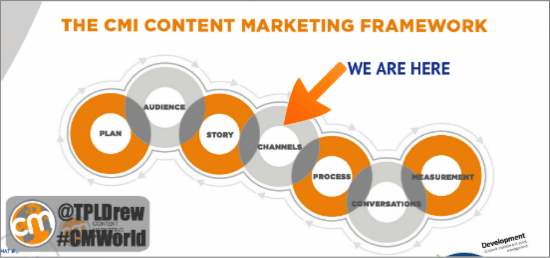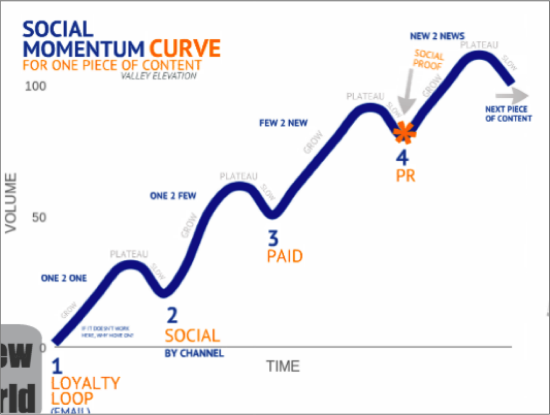
“Our content marketing success is not defined by the height of our peaks…it’s defined by the depth of our valleys.” – Andrew Davis
Andrew Davis the author of “Brandscaping: Unleashing the Power of Partnerships” has such an infectious energy that it is impossible not to sit up and listen when he is speaking. Last week, I had the pleasure of sitting front and center for Andrew’s presentation at Content Marketing World. Sadly, none of the Muppets from his previous work made a cameo, but this was by far one of my favorite sessions at the content rich conference.
According to Andrew, companies need to start rethinking the way that they “do” content marketing. This means breaking the cycle of content marketing addiction that plagues many of today’s marketers.
What is Content Marketing Addiction?
As content marketers, we are addicts. We’re addicted to the spikes in views and shares our content gets, and are always chasing the next high (spike). According to Andrew, the cycle of content marketing addiction is made up of four phases:
- Desire: You’ve just published a new piece of content marketing and have experienced a spike.
- Craving: You incessantly refresh your analytics looking for an even bigger spike.
- Rush: The content is performing so well that you capture the data and share it with everyone you know.
Crash: There has been a dip in performance, time to chase that next content marketing high.
It’s time for an intervention…
What Does Chasing the Content High Look Like?
Andrew provided the example of WestJet, a Canadian regional airline. WestJet’s YouTube channel shows years of effort put into creating videos for their audience and chasing their “next high”. They pumped out videos consistently with varying results.
However, in 2014, they struck gold with their video WestJet Christmas Miracle: real-time giving. In this video, WestJet created a kiosk that asked departing passengers what they wanted from Christmas. Then, their team frantically searched high and low for the requested gifts while passengers were en route and surprised them upon their arrival at their final destination.
What was the impact?
- The video was the #1 trending topic globally after launch.
- 1m twitter impressions in 1 month.
- There were more than 35 million video views in one month.
- The video was featured in 1600 media stories.
- Bookings were up 77% year over year and revenue was up 86%.
After the success of this video, WestJet tried their hand at some other miracle themed videos (chasing the high they received from their first major success) that performed well, but did not have nearly the impact of their initial Christmas miracle campaign.
What can companies like WestJet do to adapt their strategy to deliver longer-term success?
Do You Know Your Content Distribution Model?

Based on the steps of the CMI Content Marketing Framework, there are 7 steps to successful content marketing. However, many marketers get stuck in a content marketing cycle that dismisses process, conversations and measurement completely.
Content amplification is an essential step in the success of any content marketing program, but even with the best intentions, distribution can in execution appear to be more of a spewing of content, versus an actual, measureable distribution strategy.
An Enhanced Model For Better Content Distribution
Trip Advisor is a company that Andrew praised for their ability to focus on getting the most out of a content marketing campaign and recognizing where and when to push the content to the next phase.
Social momentum is defined as growing the quantity of consumption for a piece of content as a product of its strategic distribution over time. Below is a model similar to the one that trip advisor follows that takes queues from the plateaus of content to move onto the next phase:

When you leverage the momentum curve you end up with consistent growth.
Momentum delivers social proof. People assume the actions of others in an attempt to reflect correct behavior for a given situation.
As a consumer, you’re more like to consume and share content that others have consumed and shared. This forces us to understand the nuances of our audience and their social habits.
Ask yourself:
- When is my content consumed?
- How is my content consumed?
- Is my content consumed?
4 Secrets to Building Social Momentum
Secret #1 – Leverage Your Half-Life (one channel at a time)
Half-life is the time taken for the audience’s interest in your content to fall to half of its peak value. When it gets to the slow point that is when you want to push it to the next level.
Secret #2 – Harness the Waterfall Effect
The phenomenon that all mainstream media stories can be traced upstream to smaller, more accessible sources in a predictable pattern. Do your research to determine how to pitch. Start upstream and build relationships with the people who influence your influencers.
Secret #3 – Remove Friction
Really think about what you put in front of consumers and what they have to do to consume your content. When we tweet just a headline and a link they have to go through a lot of hoops to access your content. Stop worrying about your CTR’s. It’s not helping you, or your audience.
Secret #4 – Buy Ads
For every dollar spent on creating content spend $2 on distributing and promoting it. As marketers, we need to find new audiences to share our content with so they can be educated and inspired to purchase. What if we introduced a new audience to every piece of content we create?
Take The First Step & Break the Cycle
Andrew Davis took a complex problem that many marketers face, and broke it down into actionable and relatable steps. It doesn’t matter if you have a small or large team; companies of all sizes need to be taking steps toward truly getting the most out of content marketing programs by breaking the cycle of addiction.
What advice from Andrew was the most surprising and helpful as you sit and assess your own content marketing distribution strategy?


